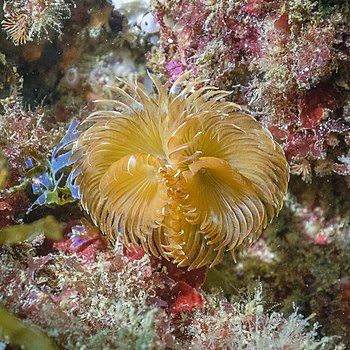Welcome to my user page! Information |
Hello!My username is A520 and I primarily revert vandalism. I am no longer on a wikibreak! I came back after a few months because I forgot my password, then I remembered it.



 | |
| Wikipedia ads | file info – show another – #176 |
Bispira volutacornis, sometimes known as the twin fan worm or spiral fan worm, is a type of tube worm found in the shallow sublittoral zone of the eastern Atlantic Ocean. It grows in crevices and in stony areas and prefers areas rich in sediment but with low levels of illumination. It has a parchment-like tube with a mucoid outer layer that is often coated with mud or silt. The tube is usually concealed in a crevice and the worm can retract into the tube when disturbed. It feeds on plankton which it captures with its plumes. It also uses the plumes to gather sediment with which to expand the tube. This B. volutavornis worm was photographed in Arrábida Natural Park, Portugal.
Photograph credit:
Diego Delso
Launch!
Atomic bomb launch
 DO NOT PRESS!
DO NOT PRESS!
Userboxes
| |||||||||||||||||||||||||||||||||||||||||||||||||||||||||||||||||
|
More userboxes at my userbox page. | |||||||||||||||||||||||||||||||||||||||||||||||||||||||||||||||||
Welcome to my user page! Information |
Welcome to my user page! Information |
Hello!My username is A520 and I primarily revert vandalism. I am no longer on a wikibreak! I came back after a few months because I forgot my password, then I remembered it.



 | |
| Wikipedia ads | file info – show another – #176 |
Bispira volutacornis, sometimes known as the twin fan worm or spiral fan worm, is a type of tube worm found in the shallow sublittoral zone of the eastern Atlantic Ocean. It grows in crevices and in stony areas and prefers areas rich in sediment but with low levels of illumination. It has a parchment-like tube with a mucoid outer layer that is often coated with mud or silt. The tube is usually concealed in a crevice and the worm can retract into the tube when disturbed. It feeds on plankton which it captures with its plumes. It also uses the plumes to gather sediment with which to expand the tube. This B. volutavornis worm was photographed in Arrábida Natural Park, Portugal.
Photograph credit:
Diego Delso
Launch!
Atomic bomb launch
 DO NOT PRESS!
DO NOT PRESS!
Userboxes
| |||||||||||||||||||||||||||||||||||||||||||||||||||||||||||||||||
|
More userboxes at my userbox page. | |||||||||||||||||||||||||||||||||||||||||||||||||||||||||||||||||
Welcome to my user page! Information |












